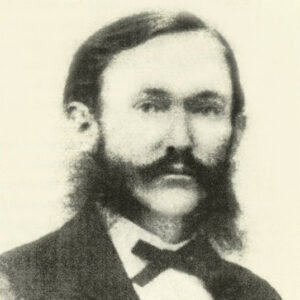calsfoundation@cals.org
John William Dunnington (1833–1882)
John William Dunnington was a Confederate naval and infantry officer during the Civil War. After serving in the U.S. Navy early in his career, he joined the Confederate navy. He served for approximately nine months in Arkansas and took part in the Engagement at St. Charles and Battle of Arkansas Post. Dunnington was rare in that he held the rank of officer in both the Confederate army and navy during the war and served both east and west of the Mississippi River.
John W. Dunnington was born on May 18, 1833, in Christian County, Kentucky, to Francis Dunnington (1798–1835) and Elizabeth Cobey Dunnington (1799–1848), both of whom were natives of Maryland. Dunnington’s brother, Francis C. Dunnington, served on Nathan Bedford Forrest’s staff during the Civil War and was a well-known Tennessee journalist. Dunnington joined the U.S. Navy in 1849, but he did not graduate from the U.S. Naval Academy until 1855. In October of the following year, he was promoted to lieutenant.
In August 1860, Dunnington was serving on board the USS Mohican when it captured the Erie, which was transporting slaves along the Congo River. The ship’s captain, the American Nathaniel Gordon, was trying to smuggle nearly 900 slaves, many of them children, out of West Africa. Gordon was brought to New York for trial under federal piracy laws and executed in 1862.
In Kentucky, a state heavily divided between those who supported the Union and those who supported the Confederacy, Dunnington sided with the secessionists. The Confederacy awarded him the rank of first lieutenant. In 1861, Dunnington was given command of the CSS Tuscarora, which served along the Mississippi until it was accidentally burned in November 1861. Dunnington next saw service on the McRae, which was then stationed at New Orleans, Louisiana. Dunnington took part in the battle at Island No. 10 in early 1862. In March, he took command of the Pontchartrain, which served in the Mississippi flotilla under Commodore George Nicolas Hollins. The Pontchartrain saw action at the June 17 Engagement at St. Charles, at which Confederates effectively lost control of the White River. Dunnington and his men inflicted serious losses on the Union navy but were forced to retreat to Little Rock (Pulaski County).
In August 1862, while in the capital, Dunnington tried to revive the dormant niter industry (for making gunpowder) in the city. He was appointed a colonel of artillery and made chief of ordnance for the entire Trans-Mississippi region. Dunnington said he had “almost unlimited authority to impress everything I deemed necessary for the use of the men and works under my command.” Dunnington reopened the Little Rock Arsenal and employed men and women there to make cartridges and repair firearms. His efforts, while limited, were successful.
In November, Dunnington was relieved of command at the arsenal so he could take charge of defending the Arkansas River. The heavy guns of the Pontchartrain were removed and used to defend Fort Hindman. The Pontchartrain was sent back to Little Rock, where it was converted to a ram. General Thomas Hindman promoted Dunnington to colonel in charge of land forces at Fort Hindman, which defended Arkansas Post. After the January attack on Arkansas Post, which resulted in a Confederate defeat, Dunnington was captured. He spent five months in a prisoner-of war-camp at Johnson’s Island in Ohio, which housed Rebel officers. Dunnington was released from prison in May 1863.
Dunnington spent most of 1864 traveling to Canada, Nassau, and Europe in an effort to secure supplies for the Confederacy. He was unsuccessful in his task and came down with yellow fever. He recovered, however, and took command of the blockade runner Owl and later the CSS Virginia (no. 2), the latter of which was part of the James River Squadron. Dunnington also served in the Naval Brigade, a land force in which he held the rank of major. At the end of the Civil War, Dunnington surrendered with Joseph E. Johnston’s forces in Greensboro, North Carolina, on April 26, 1865.
Dunnington took up farming in Maury County, Tennessee, after the war. On June 8, 1869, he married Susan Gray Booker. The couple had no children. Dunnington died on March 10, 1882, in Columbia, Tennessee, where he is buried in Rose Hill Cemetery. His wife, who lived until 1920, is buried alongside him.
For additional information:
“Capt. John W. Dunnington.” Confederate Veteran 4 (1896): 84.
“Captain John W. Dunnington.” In Confederate Military History, extended edition, Vol. XI: Kentucky. Wilmington, NC: Broadfoot Publishing Company, 1988.
John W. Dunnington to unknown recipient, December 18, 1864. Miscellaneous Letter Collection, 1809–1964. Center for Arkansas History and Culture, University of Arkansas at Little Rock, Little Rock, Arkansas.
Johnston, James J. “Bullets for Johnny Reb: Confederate Nitre and Mining Bureau in Arkansas.” Arkansas Historical Quarterly 49 (Summer, 1990): 124–167.
Colin Edward Woodward
UALR Center for Arkansas History and Culture
 Civil War through Reconstruction, 1861 through 1874
Civil War through Reconstruction, 1861 through 1874 Military
Military ACWSC Logo
ACWSC Logo  John Dunnington
John Dunnington 




Comments
No comments on this entry yet.